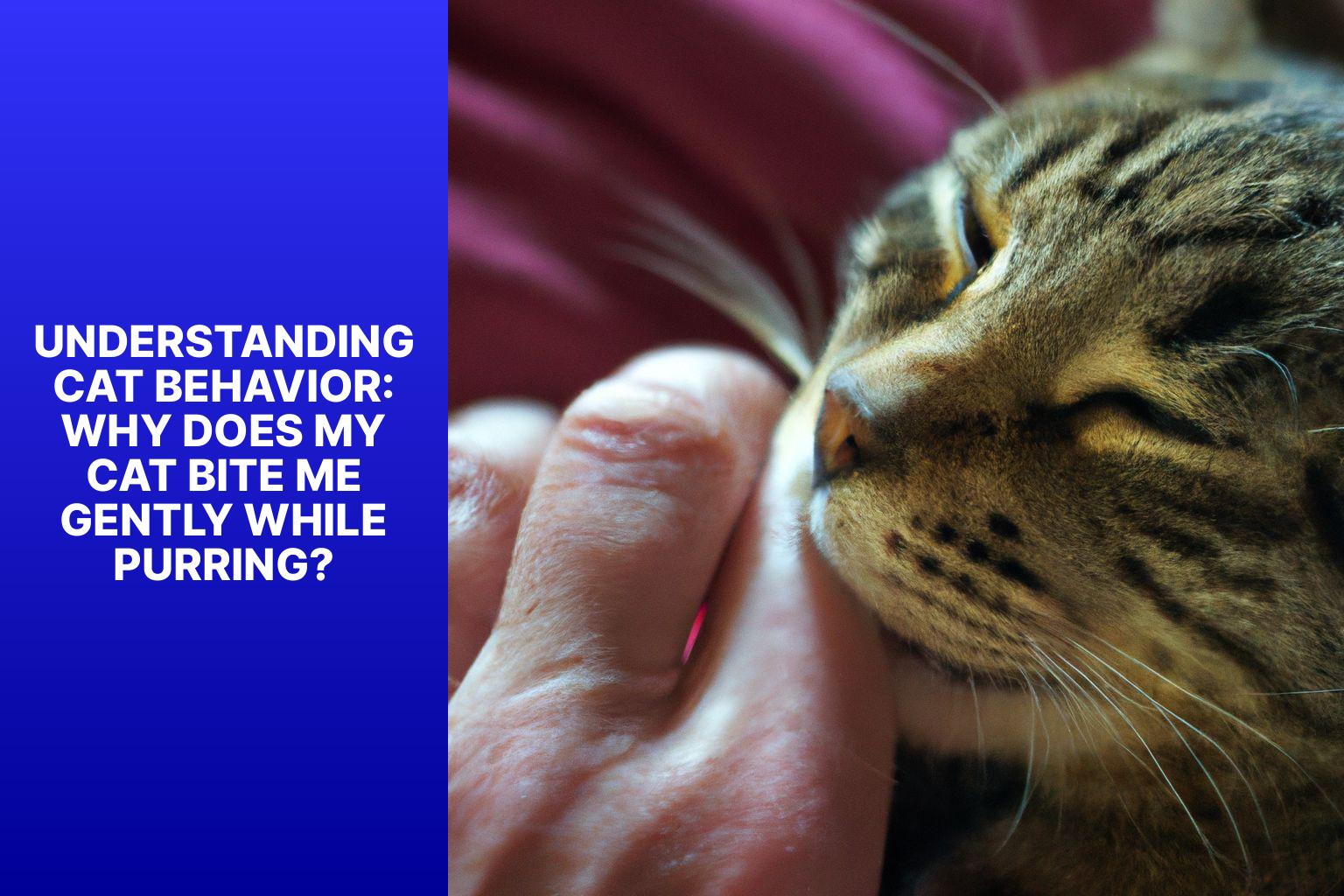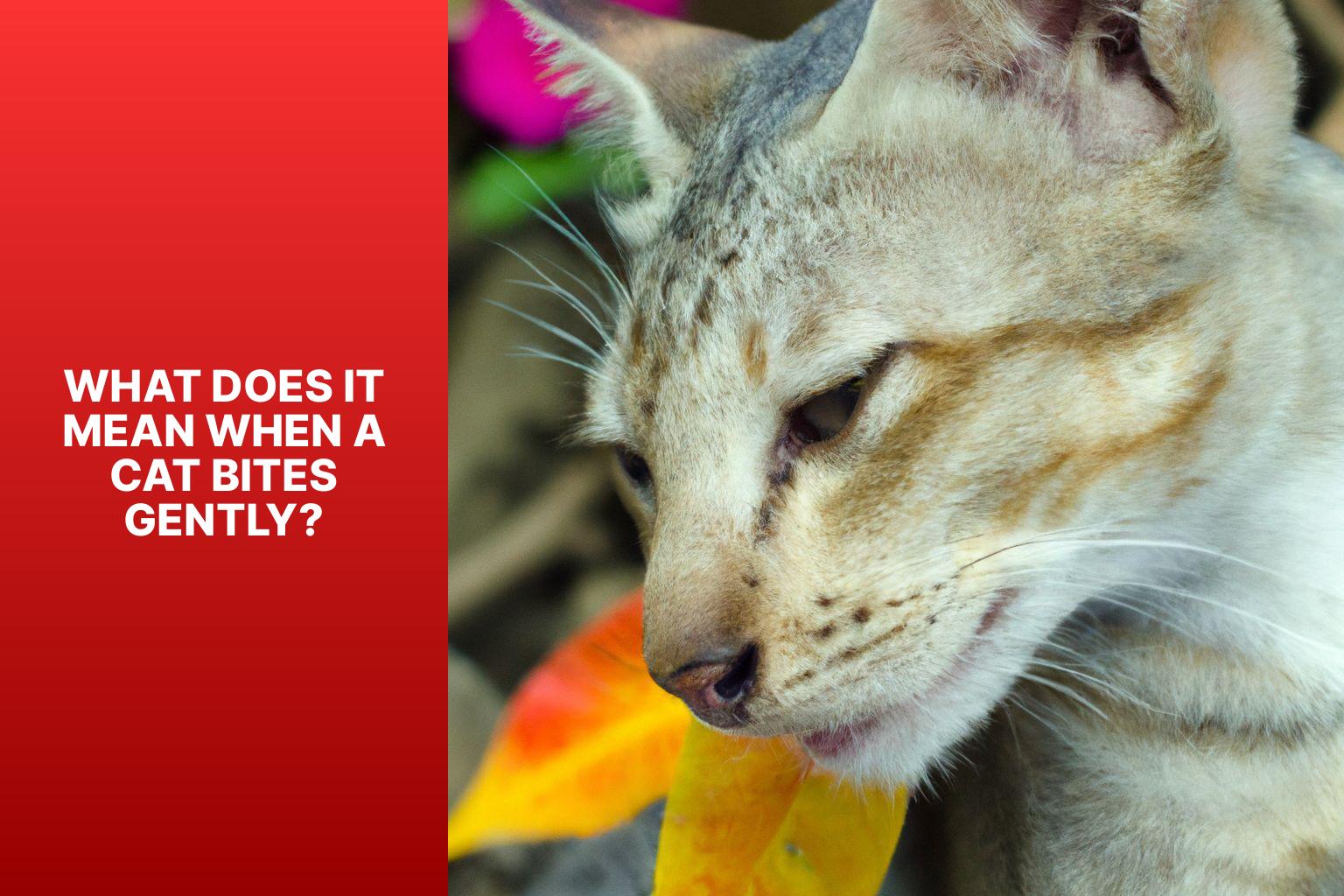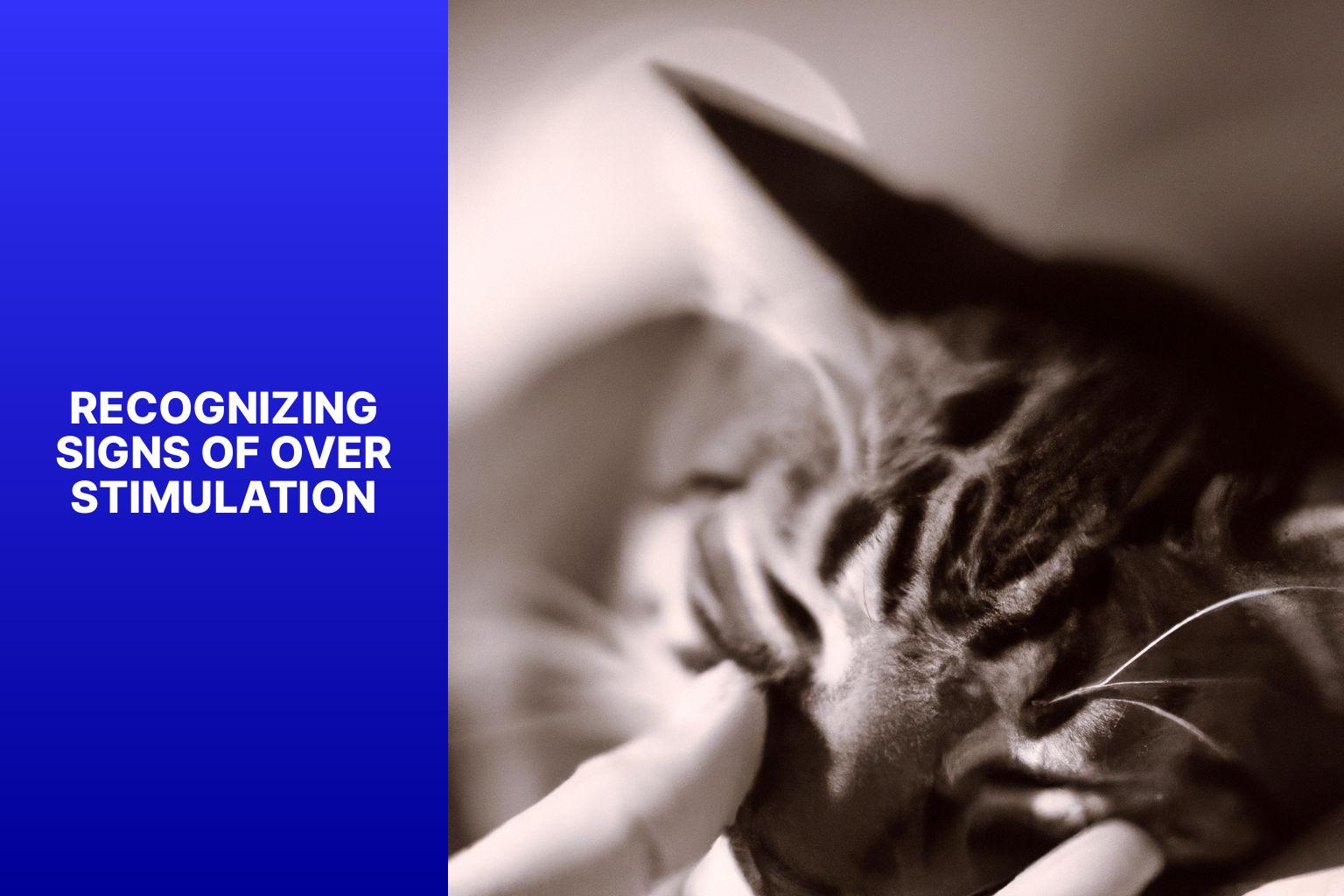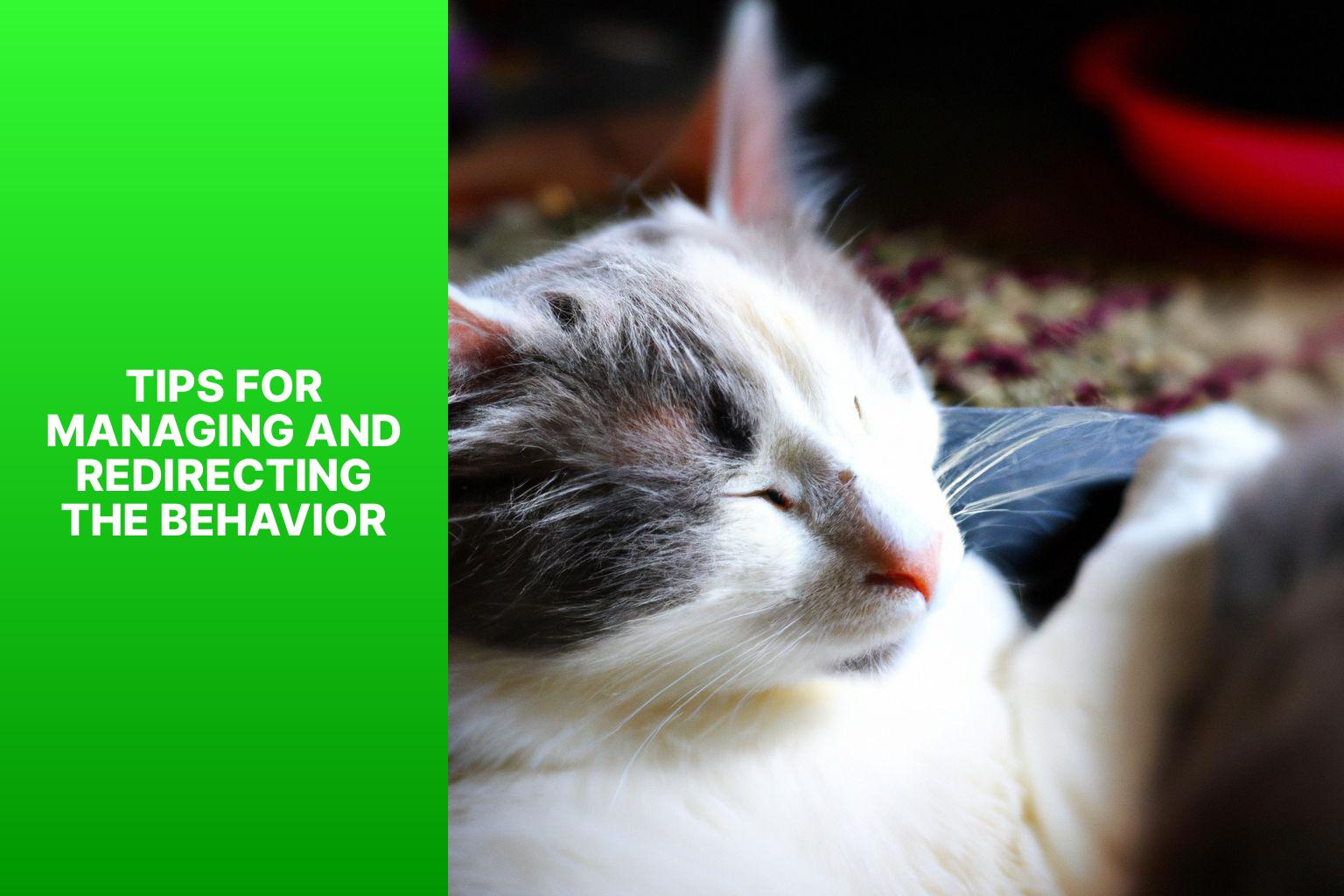Understanding Cat Behavior: Why Does My Cat Bite Me Gently While Purring?
Cats are fascinating creatures with a unique blend of sweet and playful behaviors, as well as their intrinsic predatory instincts. One common behavior that cat owners often encounter is gentle biting while purring. It can be confusing and sometimes concerning, but there are reasons behind this behavior that can help us decode our feline companions’ actions.
When a cat bites you gently while purring, it can signify different things. Here are a few possible explanations:
- Affectionate Behavior: Cats may exhibit gentle biting as a display of affection towards their owners. It can be their way of showing love and bonding with you.
- Pleasure and Contentment: Some cats will nip softly while purring when they are feeling relaxed and content in your presence. It can be a sign of their enjoyment and a way to express their happiness.
- Overstimulation: Cats have sensitive sensory systems, and in some cases, they may become overstimulated during interactions. Gentle biting can be a way for them to communicate that they have had enough and need a break.
Understanding the reasons behind gentle biting during purring can provide insight into your cat’s behavior. It can be attributed to various factors, including:
- Social Bonding: Cats use gentle biting as a means of social bonding. It can help them establish a connection with their human counterparts and strengthen their relationship.
- Communication: Cats have a range of non-verbal communication methods, including gentle biting. It can serve as a way for them to convey a message or express their desires.
- Playful Behavior: Some cats display playful behavior through gentle biting. It can be a form of interactive play that they enjoy engaging in with their owners.
- Scent Marking: Cats have scent glands in their mouths, and gentle biting can be a way for them to mark their territory and leave their scent on objects or individuals.
While gentle biting may seem harmless, it is essential to recognize signs of overstimulation in your cat. Some signs include tail flicking, dilated pupils, flattened ears, growling, or hissing. These indications suggest that your cat may be reaching their threshold and may require space or a different approach to interactions.
To manage and redirect the behavior, consider the following tips:
- Pay Attention to Body Language: Observe your cat’s body language cues to understand their mood. Look for signs of discomfort or overstimulation and respond accordingly.
- Avoid Overstimulating Your Cat: Be mindful of the duration and intensity of interactions. Give your cat breaks and respect their boundaries to prevent overstimulation.
- Provide Appropriate Toys and Playtime: Engage your cat in interactive play sessions using toys to redirect their biting behavior and provide a suitable outlet for their energy.
By understanding the reasons behind gentle biting while purring and implementing appropriate strategies, you can enhance your bond with your feline friend and foster a harmonious relationship.
Key takeaway:
- Understanding cat behavior: Cats may gently bite while purring due to their dual nature of being sweet and playful, yet also predatory.
- Interpreting gentle biting: Gentle biting during purring can indicate affectionate behavior, pleasure and contentment, or overstimulation.
- Reasons behind gentle biting: Gentle biting serves various purposes including social bonding, communication, playful behavior, and scent marking.
- Recognizing signs of overstimulation: Signs such as tail flicking, dilated pupils, flat ears, or growling/hissing indicate that the cat may be overstimulated.
- Managing and redirecting the behavior: Pay attention to your cat’s body language, avoid overstimulation, and provide appropriate toys and playtime to manage and redirect the biting behavior.
Understanding Cat Behavior: Why Does My Cat Bite Me Gently While Purring?
Photo Credits: Www.Catcornerblog.Com by Alan Williams
To understand why a cat may bite while purring, it is important to consider various factors. Love and affection play a significant role in this behavior as cats may gently bite as a form of displaying their love and affection towards their owners. This behavior is often accompanied by purring, which indicates that the cat is content.
Another reason for gentle biting is playfulness. Cats often use gentle biting as a way to initiate play and express their desire for interaction. By doing so, they try to engage their owners in a fun and playful manner.
Cats also exhibit gentle biting behavior to mimic their hunting instincts. Through gentle biting, they practice their hunting techniques and display their natural behavior. It is a way for them to fulfill their natural instincts and exhibit their hunting skills.
Cats may resort to gentle biting in response to sensitive petting. Each cat has different sensitivity levels to touch, and gentle biting can be a response when they are being petted in sensitive areas. Therefore, it is important to pay attention to the cat’s body language and avoid those areas if the cat responds negatively.
To prevent any harm or discomfort, there are some suggestions that can be followed. Observing the cat’s body language is crucial as it can give signs of discomfort or stress, such as flattened ears or a flicking tail. By paying attention to these signs, one can identify when the cat is uncomfortable and take appropriate action.
Providing appropriate toys is another way to redirect biting behavior. Cats have a natural instinct to hunt, and by offering toys that satisfy their hunting instincts, they can be distracted from biting human hands or other inappropriate objects.
Handling the cat gently is essential in building trust and minimizing the chances of biting. Rough play or forceful petting should be avoided, and instead, slow and gentle movements should be used when interacting with the cat. This will create a calm and safe environment for both the cat and its owner.
The Dual Nature of Cats: Sweet and Playful, But Also Predatory
Cats have a dual nature in their behaviors. They can be both sweet and playful, but they also have a predatory side. This is seen when they gently bite while purring. This behavior is not aggressive, but rather a playful gesture. Cats do this when they want to play with their owners. Cats have an instinct to hunt and pounce, and play biting helps them practice these skills.
To prevent unwanted biting or scratching, it’s important to provide cats with appropriate outlets for their predatory instincts. Interactive toys, like feather wands or laser pointers, can redirect their hunting behaviors in a safe way.
Some cats may exhibit more predatory behaviors due to their personalities and past experiences. Limited exposure to hunting can increase a cat’s desire to play bite.
I had a cat named Whiskers who was playful and sweet. While cuddling and purring, he would gently nibble my hand. At first, I thought he was being aggressive, but after researching and consulting a veterinarian, I learned that he had a dual nature – both sweet and predatory. It was his way of showing affection and playing. I ensured he had plenty of interactive toys and playtime, which significantly reduced the play biting. Whiskers taught me the importance of understanding cats’ dual nature for a happy relationship with them.
What Does it Mean When a Cat Bites Gently?
Photo Credits: Www.Catcornerblog.Com by Anthony Allen
Curious about what it means when your feline friend gives you gentle bites while purring? Let’s dig into this intriguing behavior in cats. In this section, we’ll explore three possible reasons behind this behavior: affectionate behavior, pleasure and contentment, and overstimulation. Get ready to unravel the hidden messages your cat may be sending you through these gentle bites.
1. Affectionate Behavior
Affectionate behavior is why cats bite gently while purring. It shows love and affection towards their owners. Here are key aspects of affectionate behavior in cats:
– Head bumps and rubbing against you: Cats lean their heads into your hand or rub against your leg to mark you with their scent. This behavior shows affection and that they consider you part of their social group.
– Gentle nibbling: Cats may give gentle bites as exploration or to show affection. This behavior is accompanied by purring and is a sign of trust and love.
– Slow blinking: When a cat looks at you and slowly blinks, it signifies relaxation and trust. This behavior, known as a “kitty kiss,” conveys affection and contentment.
Fact: Affectionate behavior in cats releases oxytocin, the “love hormone,” strengthening the bond between cats and their owners.
2. Pleasure and Contentment
Cats purr when they are happy. Gentle biting is also a way for cats to show affection and communicate satisfaction, expressing their pleasure and contentment. This behavior can help strengthen the bond between cats and their human companions, ensuring mutual pleasure and contentment.
It is important to pay attention to a cat’s body language and recognize signs of overstimulation to maintain their pleasure and contentment. If a cat shows signs of discomfort or aggression, it is important to respect their boundaries and give them space to ensure their pleasure and contentment.
Providing appropriate toys and playtime can help manage and redirect this behavior in a safe and stimulating manner, promoting their pleasure and contentment. Foster a harmonious and enjoyable relationship with your cat by understanding their preferences and boundaries, thus ensuring their pleasure and contentment.
3. Overstimulation
Some key factors to consider about overstimulation in cats include:
1. Physical sensitivity: Some cats are more sensitive to sensory stimulation, making them more prone to overstimulation.
2. Excessive petting: Overpetting or rough petting can overwhelm a cat, leading to gentle biting to communicate discomfort.
3. Body language: Pay attention to your cat’s body language, such as twitching tail, flattened ears, dilated pupils, or growling/hissing. These signs indicate possible overstimulation.
4. Playtime: Cats need regular playtime to release energy and satisfy their predatory instincts. Provide appropriate toys and engage in play to prevent overstimulation.
5. Environment: Create a calm environment free from stressors that can contribute to overstimulation in cats.
It is important to understand your cat’s boundaries and respect their limits. By being mindful of their body language and providing appropriate outlets for play and stimulation, you can minimize the chances of overstimulation and gentle biting behavior. If you have concerns about your cat’s behavior, consult a veterinarian or animal behaviorist.
Reasons Behind Gentle Biting During Purring
Curious about why your cat gently bites you while purring? Look no further! In this fascinating section, we’ll uncover the reasons behind this adorable behavior. From social bonding and communication to playful antics and scent marking, we’ll dig into the various explanations for your furry friend’s gentle bites. Get ready to gain a deeper understanding of your cat’s complex nature and strengthen your bond with them. Let’s dive in!
1. Social Bonding
Cats bite gently while purring to enhance social bonding. They engage in various behaviors to establish connections with their human companions. Here are ways in which gentle biting during purring can demonstrate social bonding:
1. Allogrooming: Cats groom each other to bond, and gentle biting can be a part of this behavior. When a cat nibbles on you while purring, it may be imitating this grooming and displaying affection.
2. Trust and comfort: Cats feel relaxed and at ease when with someone they trust. By gently biting while purring, a cat expresses trust and comfort in your presence.
3. Mutual interaction: Cats engage in interactive play with their companions, and gentle biting can be a part of this behavior. It invites you to play and strengthens the bond.
4. Communication: Cats communicate using vocalizations, body language, and physical touch. Gentle biting while purring is a way for a cat to show affection and connection.
A true story illustrating social bonding between cats and humans involves Whiskers, a stray cat who found a loving home. Despite an initial fear, Whiskers quickly formed a strong bond with her new owners. She would sit on their laps, gently nibbling their fingers while purring contently. This behavior became a regular part of Whiskers’ social bonding routine, symbolizing trust and affection for her human companions.
2. Communication
Communication is a crucial aspect of a cat’s behavior. Understanding the various methods they use to communicate can help us interpret the meaning behind their gentle bites while purring.
Cats primarily communicate through body language, which includes postures and facial expressions. When a cat gently bites while purring, it can indicate that they are content and affectionate.
In addition to body language, cats also use vocal cues to communicate with their owners. They may chirp, meow, or purr to express their needs or desires. Therefore, a gentle bite while purring can be a way for them to convey happiness and a longing for attention or interaction.
Cats have scent glands in their mouths. Thus, a gentle bite during purring can serve as a means for them to mark their territory and communicate ownership or affiliation.
It is important to note that cats often use gentle biting as a part of play. It is crucial for us to differentiate between playful bites and aggressive ones. Playful bites are typically accompanied by relaxed body language and a playful demeanor.
By understanding the communication behind a cat’s gentle bites during purring, we can develop a stronger bond with our feline companions. This understanding will ensure a harmonious relationship based on trust and mutual understanding.
3. Playful Behavior
Cats exhibit playful behavior by biting gently while purring for various reasons. These include:
- Social interaction: Cats engage socially with their owners by using gentle biting while purring.
- Hunting instinct: As a way to express their natural hunting behaviors, cats may bite gently while purring.
- Communication: Cats use gentle biting while purring to communicate their needs or desires.
- Bonding: Playful biting between a cat and their owner can be a sign of affection and trust.
- Exploration: Cats interact with their environment by using gentle biting.
While gentle biting is often a playful behavior, it’s essential to establish boundaries and redirect this behavior appropriately. Providing suitable toys and playtime can satisfy a cat’s playful instincts and discourage biting inappropriate objects or surfaces.
4. Scent Marking
The sub-topic “4. Scent Marking” in cat behavior helps us understand why cats bite gently while purring.
– Cats naturally engage in scent marking. They have scent glands on their cheeks, forehead, paws, and tail base.
– Biting gently while purring allows cats to transfer their scent and mark their territory or presence.
– Scent marking also helps cats communicate with other cats, conveying information about their status, reproductive availability, or familiarity with their surroundings.
– Cats may display scent marking behavior when they are content or relaxed, using gentle biting and purring to show their comfort and satisfaction.
– It’s important to note that gentle biting during purring can have various reasons other than scent marking, such as social bonding, communication, or playfulness.
Understanding the reasons behind scent marking behavior can help cat owners interpret their pet’s actions and create a harmonious living environment.
Recognizing Signs of Overstimulation
Photo Credits: Www.Catcornerblog.Com by Frank Johnson
Ever wondered why your purring feline companion suddenly bites you gently? In order to better understand this behavior, we must be able to recognize the signs of overstimulation in our cats. Watch out for tail flicking, dilated pupils, flat ears, and even the occasional growl or hiss. Each of these subtle cues can give us insight into your cat’s emotions and state of mind. By paying attention to these signs, we can foster a happier and healthier relationship with our feline friends.
1. Tail Flicking
Tail flicking is a common behavior in cats, with various meanings. Cats may exhibit tail flicking for communication, agitation, excitement, or concentration. When a cat flicks its tail, it could indicate agitation, warning, or playfulness. It is important to observe other body language signals, such as dilated pupils, flattened ears, growling, or hissing, along with tail flicking to better understand the cat’s state of mind. If these behaviors are present, the cat may be overstimulated and might need some alone time. To effectively manage and redirect this behavior, it is recommended to provide a calm and quiet environment, give the cat space, or engage them with toys.
2. Dilated Pupils
Dilated pupils in cats provide insight into their emotional state and level of arousal. Here are some important points to consider:
1. Increased alertness: Cats’ pupils dilate when they become more alert. This indicates that the cat is paying attention to their surroundings and may be ready to play or hunt.
2. Excitement or fear: Dilated pupils can also indicate excitement or fear. If a cat’s pupils are dilated while gently biting during purring, it may suggest they are excited or apprehensive about the interaction.
3. Nervousness or anxiety: In some cases, dilated pupils can be a sign of nervousness or anxiety. If a cat is displaying other signs of stress, such as flattened ears or growling, dilated pupils may indicate they are feeling overwhelmed or uncomfortable.
4. Exploration: Cats’ pupils naturally dilate when they are exploring. If a cat is investigating a new environment or object, their pupils may become larger to improve vision in low-light conditions.
It is important to consider a cat’s overall body language and behavior alongside pupil dilation. This will help better understand their emotions and respond appropriately to their needs.
3. Ears Flat
When a cat’s ears are flat, it signifies a behavior or emotional state. Cats flatten their ears for several reasons:
- Fear or Aggression: Flat ears indicate that a cat feels threatened or aggressive. It’s a defensive posture that makes the cat appear larger and more intimidating.
- Overstimulation: Cats flatten their ears when they are overstimulated during play or petting. It’s a way for them to communicate that they need a break.
- Pain or Discomfort: If a cat is in pain or discomfort, they may flatten their ears as a reaction.
- Anxiety or Stress: Flat ears can also be a sign of anxiety or stress in cats. It’s a way for them to protect themselves and appear smaller.
It’s important to consider the context and other body language of a cat when interpreting flat ears. If a cat’s ears are flat and accompanied by other signs of aggression, it’s advisable to give the cat space and avoid triggers. If the flat ears are due to overstimulation during play or petting, it’s best to stop and give the cat a break. Understanding a cat’s body language can help build a better bond and ensure their well-being.
4. Growling or Hissing
- Cats may growl or hiss when they feel threatened or agitated.
- Growling is a deep, low sound that cats make to express anger or displeasure.
- Hissing is a sharp sound made when cats feel threatened and want to intimidate potential threats.
- Growling and hissing can occur during playtime if the cat gets too excited or overstimulated.
- These behaviors are warning signs for others to back away or give the cat space.
- Avoid provoking or engaging with the cat when it is growling or hissing to prevent aggression.
- Give the cat time and space to calm down before attempting further interaction.
- Understand a cat’s body language and cues to prevent situations that may lead to growling or hissing.
Tips for Managing and Redirecting the Behavior
Photo Credits: Www.Catcornerblog.Com by Charles Rivera
Looking to manage and redirect your cat’s gentle biting behavior while purring? Here are some handy tips to help you out. Paying close attention to their body language is key, as it can provide valuable insight into their mood and intentions. Avoiding overstimulation is also crucial, as it may trigger gentle biting episodes. Providing appropriate toys and playtime can help channel their energy and reduce the likelihood of biting incidents. Let’s dive into these strategies and create a harmonious environment for both you and your furry friend.
1. Pay Attention to Body Language
Pay Attention to Body Language
Pay attention to your cat’s body language to better understand their behavior and prevent unwanted biting. By observing their tail, you can determine if they are feeling irritated or overstimulated. Watching their ears can give you insights into their aggression or fear levels. Take note of their eyes as well, as dilated pupils may suggest excitement or aggression. It is also important to pay attention to their body posture, as tense or low crouching positions may indicate that they are ready to pounce or attack. Vocalizations such as growling or hissing can signify that they feel threatened or aggressive.
Understanding your cat’s body language is vital in determining their comfort and need for personal space. By being attuned to these cues, you can create a safer and more enjoyable environment for both you and your cat.
In my friend’s case, her cat would gently bite when overstimulated during playtime. Fortunately, she was able to recognize signs like tail flicking and dilated pupils. By providing appropriate toys and playtime activities, she effectively managed and redirected the cat’s behavior. She closely monitored the cat’s body language to ensure a positive and safe interaction.
2. Avoid Overstimulating Your Cat
The sub-topic “Avoid Overstimulating Your Cat” provides important guidelines for your feline friend’s well-being and happiness. Here are some tips to avoid overstimulation:
– Pay attention to your cat’s body language. Signs of discomfort, such as tail flicking, flattened ears, and dilated pupils, indicate that your cat may be approaching their stimulation threshold.
– Provide appropriate toys and playtime. Engage your cat in interactive play using toys that allow them to exhibit their natural hunting instincts, such as puzzle feeders or feather wand toys.
– Create a calm environment. Cats thrive in quiet and calm surroundings. Avoid loud noises or sudden movements that may startle or stress your cat. Designate a safe space where they can retreat for quiet time.
Remember, overstimulation can lead to negative behaviors like biting or aggression. By following these tips and considering your cat’s needs, you can create a harmonious and stress-free environment for your furry companion.
Did you know that cats have an acute sense of hearing? This is why sudden loud noises can easily startle them. Providing a calm and peaceful environment can help them feel safe and secure.
3. Provide Appropriate Toys and Playtime
Providing appropriate toys and playtime for cats is crucial for their overall well-being. Here are some ways to ensure that your cat receives the playtime they require:
– Opt for interactive toys: Engage your cat in play by choosing toys like feather wands or puzzle toys. These toys allow them to chase, pounce, and utilize their natural instincts.
– Regularly rotate toys: Keep playtime exciting by frequently switching out toys. Introduce new toys and store away old ones for a while before bringing them back out later.
– Engage in regular play sessions: Play with your cat using interactive toys that imitate prey, such as toy mice or laser pointers. This helps to keep them active and engaged.
– Provide scratching posts and climbing options: Cats need outlets for scratching and climbing. Offer appropriate scratching posts and tall structures like cat trees to satisfy their natural behaviors.
– Designate play zones: Designate specific areas in your home as play zones for your cat. These areas can include toys, scratching posts, and climbing structures to encourage exploration and play.
By providing appropriate toys and playtime, you can keep your cat entertained, stimulated, and content. Always supervise playtime and ensure that the toys are safe and suitable for your cat’s size and age.
Some Facts About Why Cats Bite Gently While Purring:
- ✅ Cats may gently bite their owners while purring to indicate that they are overstimulated and need some space. (Source: The Happy Cat Site)
- ✅ Gentle biting can also be a sign of anxiety or fear, with kittens biting more gently and older cats biting more aggressively. (Source: The Happy Cat Site)
- ✅ Cats may also bite while purring to mark their territory or to play and bond with their owners. (Source: The Happy Cat Site)
- ✅ It is important to recognize the warning signs that a cat is unhappy, such as tail movements, ear movements, and changes in body posture. (Source: The Happy Cat Site)
- ✅ To reduce the chances of being bitten, owners should read their cat’s body language, increase playtime, and reward positive behaviors. (Source: The Happy Cat Site)
Frequently Asked Questions
Why does my cat gently bite me while purring?
There are several reasons why your cat might gently bite you while purring:
- Love Bites: Gentle biting can be a way for cats to communicate that they have had enough attention and need a break.
- Territorial Purring: Cats may bite while purring to mark their territory and show that they consider you a part of their territory.
- Over Stimulation: Cats may become overstimulated during play and bite to signal that they need some space.
How can I tell if my cat is fed up and about to bite?
Cats often give signals before biting, and being aware of their body language can help you anticipate when they are fed up:
- Tail Movements: Watch for changes in tail movements. A flicking or lashing tail may signal that your cat is becoming annoyed.
- Ear Movements: Cats use their ears to communicate their mood. If your cat’s ears are flattened or twitching, it may be a sign that they want to be left alone.
- Body Posture Changes: Crouching or staring with partially closed eyes can indicate that your cat is getting annoyed or needs a break from petting.
How can I stop my cat from biting while purring?
To stop your cat from biting while purring, you can try the following:
- Counter Conditioning: Use positive reinforcement techniques to associate gentle play and kind attention with good behavior.
- Increase Playtime: Engage your cat in interactive play sessions to provide an outlet for their energy and reduce the chances of them becoming overstimulated.
- Behavior Correction: If your cat starts biting, stop the activity immediately and give them a bit of space to calm down. Redirect their attention to a favorite toy.
Can gentle biting while purring be a sign of aggression?
Gentle biting while purring is typically not a sign of aggression, but rather a way for cats to communicate their need for space or a break. It is important to differentiate between gentle bites and aggressive bites, as aggressive bites are usually accompanied by growling and can be painful.
Why should I avoid direct eye contact with an aggressive cat?
Direct eye contact can be perceived as a challenge or threat by an aggressive cat. To avoid escalating the situation, it is best to give the cat some space and avoid staring directly into their eyes.
When should I seek veterinary help for my cat’s biting behavior?
If your cat’s biting behavior becomes more aggressive or frequent, it may be a sign of an underlying health issue or a behavioral problem that requires professional intervention. It is best to consult with your veterinarian to rule out any medical conditions and get appropriate guidance for managing your cat’s behavior.






